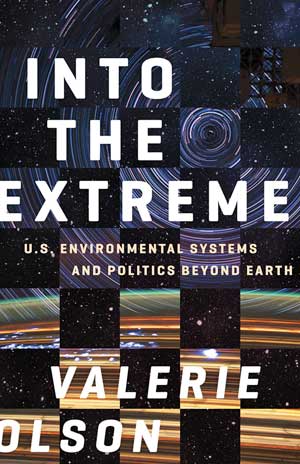
Into the Extreme offers an unusual look into the vast domain of U.S. human spaceflight. I wrote it after doing years of fieldwork in its workplaces that are off-limits to the public. Usually, social and historical studies of human spaceflight focus on rocketry or international relation-building. Instead, my exposure to the everyday work of sending people beyond Earth prompted me to focus on the two basic cultural ideas that spaceflight depends on and extends into the universe: “system” and “environment.”
These are humble everyday terms. But they are also historically loaded concepts of relationality that have come to empower Western thought, technical practice, and global interactions. The “system” concept emerged as a theoretical organizing principle during the Enlightenment, when it became clear to astronomers gazing through telescopes and biologists peering into microscopes that it wasn’t just important to know what things are but how they are interrelated. “System” became the official term for designating parts in relation to kinds of wholes, and for presenting those wholes as connected or separate from one another. “Environment” emerged in the nineteenth century as a term with which to think about the exterior forces that form systems.
Today, the “system” and “environment” concepts influence how people speak about and question what is included or excluded from worlds that matter: social, political, ecological. People speak of joining systems and beating them; people love environments and fight over them. Spaceflight elaborates and extends these concepts more intensively than most other types of social practice. I did fieldwork for my book in sites where living systems are being experimented on, artificial environments are being built, and far-off unEarthly environments are being connected to U.S. institutions through modes of occupation and remote sensing.
The book is therefore grounded in the anthropological understanding that social groups have different ideas about how things are connected. Such ideas can be extremely powerful but can also be completely taken for granted. People may not question how such concepts are cultivated or how they shape the worlds they live in. As an anthropologist, I have been pursuing this question: What are some basic concepts of relatedness that motivate thought, action, and power?
As a result, the chapters of the book engage a few key questions: What can spaceflight practices and social activities teach us about these basic relational ideas that inform diverse U.S. political perspectives, technical practices, and imaginations of futures? Or about how experts control what counts as “in” or “out” of relation? Or about how modern cosmologies get produced? I attempt to answer these questions by taking the U.S. relationships with the solar system as its object of study.
I was a graduate student at Rice University in Houston Texas when the space shuttle Columbia disintegrated overhead as it was returning to Earth. I watched communities in and around Houston go into grief and shock, and I tracked news from NASA as it grounded its fleet and investigated the accident. This compelled me to seek an understanding of the complex hidden worlds of spacefaring. I ended up going into places that have been prohibited to outsiders, and spending time with people who are trying to create the connections, separations, and artificial environments that keep living things alive in spaces beyond Earth.
So, what are spaceflight-based ways of thinking and building? I was curious about spaceflight’s most quotidian and far-out environmental systems work. My book begins with underwater “space analog” training missions that draw the sea and outer space together. It goes into space biomedicine networks, where astronauts are managed as one among other systemic parts of a larger mission system. I examine how spacesuit and space habitat design problems force engineers and architects to challenge cultural ideas about the “natural” boundaries between bodies and spaces. I end by examining how new attempts to manage “space weather” (asteroids, solar radiation) extends global economic and environmental politics beyond Earth’s atmosphere.
In NASA, every kind of thing, from a human body to a spacecraft to a galaxy is described as a system within a broader system. The spaces that matter to keeping humans alive in space, like the tiny space between one cell and another, or the incomprehensible expanses of galactic and intergalactic space, are understood to be environments.
In this way, spaceflight systems work has both a conceptual and political impact: it authoritatively universalizes a way of thinking about relations and spaces. The book calls attention to Western cultural conceits about human exceptionalism and boundaries, and also to the ways that spaceflight programs in and out of the U.S. produce new ways to the relational interdependence of living and nonliving things.
I hope the reader will thumb through the book and check out the images and illustrations. U.S. human spaceflight is both a civil and a military activity, which means that it produces images that are offered to the public at large as well as images that are kept secret. I included lots of fair access images that call attention to the stolidly technical and extravagantly creative spectrum of government environmental systems work.
While browsing through the book, I hope readers will also take a look at the quotes I got from the many people I worked with and interviewed. Spaceflight stories are usually focused on high-profile machines, astronauts, and events. As an ethnographer, I’m also interested in portraying the work of the spaceflight scientists, engineers, technicians, and student interns who show up at the gates of spaceflight centers every day.
I had, literally, thousands of images, to choose from and hundreds of pages of interviews and fieldwork notes to build this book from; I selected those that I felt would support my analytic goals, namely to call attention to the ways the contemporary solar system is being produced as a sociocultural, and political, environment. In this way, I situate space and spaceflight in the unfolding arenas of environmental history and politics.
Formaly speaking, this book is about spaceflight as a form of national environmental power. But it is also a story about a far-flung network of people who socialize and act politically in terms of systems and environments. Taken together and at large, the concepts of system and environment are sentinel Western symbols and tools. They have been deployed to build weapons of mass destruction, to govern colonized peoples, to manage institutions, and also to invent the discipline of ecology. They structure debates about how to understand the semi-closed environmental dimensions of Earthbound life, and also how to build ships to leave this Earth forever. I want readers to see spaceflight as one among lots of kinds of work being done to know and manage environmentally-defined space.
People ask me if I’m for or against the system idea, but I didn’t do this project in order to celebrate or debunk the concept or to provide an alternative. Rather, I wrote this book to generate an informed discussion about where the concept came from, who is empowered to do systems work, and how that work is done. The system concept can draw people together or keep them apart, depending on the ways in which it is imagined to be more or less closed or open. And there are other forms of cultural knowledge about interdependent relations, such as those found in Buddhist theories of non-self and non-separation, which provide socially inclusive ethical rubrics that the system concept lacks. I hope the book generates debate about all kinds of relational ideas and their compatibilities and incompatibilities.
People also expect me to weigh in on the value of human spaceflight, but this is an issue I simply hope to open to new attention. Spaceflight’s future in the U.S. is uncertain, and people continue to argue about whether it is right or wrong; in any case, it is a persistently charismatic social practice, and as an anthropologist, my aim is to critically and compassionately represent forms of social practice. While U.S. spaceflight furthers imperial goals and scientific cultures, it cannot be reduced to them. It is a sector of the U.S. workforce that includes an aging governmental population, but that is also attracting young workers to private enterprises focused on dreams of otherworldly life. There are people who pursue spaceflight to enhance social liberation and environmental integration, as well as to build colonial economies. The complexities of U.S. spaceflight lie in its sociocultural as well as technical systematicities.
According to people I met during fieldwork, humans already live in outer space because their planet is in outer space — so going further is not going outside where we live. This is hard to disagree with in principle, but what it points to, and what I hope the book conveys, is something more fundamental: that it is of crucial importance how social groups organize around senses of being related and of living in an unbounded world.


Valerie Olson is Associate Professor of Anthropology at UC Irvine.